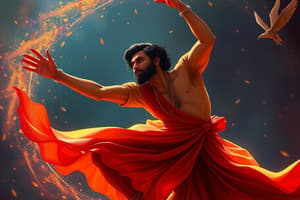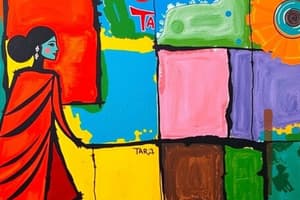Podcast
Questions and Answers
Which of the following best describes the central theme of the story?
Which of the following best describes the central theme of the story?
- The benefits of a strong landlord system for community development.
- The bond between a man and his bull amidst harsh conditions. (correct)
- The importance of religious rituals in rural Bengal.
- The complexities of village politics in India.
Sarat Chandra Chatterjee's first story was published after 1910.
Sarat Chandra Chatterjee's first story was published after 1910.
False (B)
What compels Gafur and Amina to finally leave their village?
What compels Gafur and Amina to finally leave their village?
The tragic death of Mahesh and the bleak prospects for survival.
The village of ___________ is where the story primarily unfolds, depicting the harsh realities of drought.
The village of ___________ is where the story primarily unfolds, depicting the harsh realities of drought.
What does Gafur do to bring Mahesh back after Manik Ghose sends him to the police station?
What does Gafur do to bring Mahesh back after Manik Ghose sends him to the police station?
Tarakaratna, the village priest, is portrayed as a compassionate and selfless individual who actively supports the impoverished villagers.
Tarakaratna, the village priest, is portrayed as a compassionate and selfless individual who actively supports the impoverished villagers.
Explain why Gafur ultimately kills Mahesh.
Explain why Gafur ultimately kills Mahesh.
Before leaving Kashipur, Gafur prays to Allah, seeking justice against ___________ but accepting any punishment for himself.
Before leaving Kashipur, Gafur prays to Allah, seeking justice against ___________ but accepting any punishment for himself.
Examine the multifaceted symbolism of water scarcity in 'Drought.' What deeper societal issues does it represent beyond mere physical deprivation?
Examine the multifaceted symbolism of water scarcity in 'Drought.' What deeper societal issues does it represent beyond mere physical deprivation?
Assess the extent to which the story challenges or reinforces traditional fatalistic beliefs. How does Gafur embody or defy these beliefs?
Assess the extent to which the story challenges or reinforces traditional fatalistic beliefs. How does Gafur embody or defy these beliefs?
Flashcards
Kashipur
Kashipur
A small, drought-affected village where the story takes place.
Gafur
Gafur
A poor weaver who loves his bull, Mahesh, like family.
Mahesh
Mahesh
Gafur's bull, loyal but suffering from hunger.
Tarakaratna
Tarakaratna
Signup and view all the flashcards
The Zamindar
The Zamindar
Signup and view all the flashcards
The drought worsens
The drought worsens
Signup and view all the flashcards
Leaving the village
Leaving the village
Signup and view all the flashcards
Gafur's struggles
Gafur's struggles
Signup and view all the flashcards
Drought and Despair
Drought and Despair
Signup and view all the flashcards
Moral of the story
Moral of the story
Signup and view all the flashcards
Study Notes
About the Author
- Sarat Chandra Chatterjee (1876-1938) was a prominent Bengali novelist and short story writer.
- "Mandir," Chatterjee's first story, was published in 1907.
- Chatterjee's works provide an authentic depiction of rural Bengal.
- Famous works include Pandit Mosai, Pathnirdesh, Bindur Shele, Ramer Sumati, Kashinath, and Sitar Banabas.
Background of the Story
- The story is set in Kashipur, a poor village suffering from drought.
- The villagers are under the control of a cruel landlord (Zamindar).
- Gafur, a poor weaver, and his bull, Mahesh, struggle to survive in difficult times.
Characters and Places
- Gafur is a poor weaver who loves his bull, Mahesh, like family.
- Amina is Gafur's young daughter who tries to help her father.
- Mahesh is Gafur's loyal bull, suffering from hunger.
- Tarakaratna is a selfish and uncaring village priest.
- Manik Ghose is a rich man who sends Mahesh to the police station.
- The Zamindar is the cruel landlord who punishes Gafur.
- Kashipur is a small, drought-affected village where the story takes place.
Key Events and Struggles
- Gafur is very poor and cannot feed Mahesh, using old straw from his roof, which Amina criticizes.
- Mahesh disappears after eating plants from a rich man's garden and is taken to the police station.
- Gafur pawns his brass plate to bring Mahesh back from the police station.
- Gafur refuses to sell Mahesh, as he considers him part of the family.
- The weather worsens, and Gafur and Amina lack food and water, leading Gafur to slap Amina in frustration.
- The landlord beats Gafur because Mahesh ate some crops, weakening Gafur.
- In frustration, Gafur kills Mahesh and regrets his actions.
- Gafur and Amina leave the village to start a new life, and Gafur prays for justice against the landlord.
Summary
- The story is set in Kashipur, where tenants live in fear of the cruel Zamindar (landlord).
- Tarakaratna, the village priest, questions Gafur about Mahesh being tied up without food.
- Gafur feeds Mahesh straw from his roof, which is weak, and Amina scolds him.
- Manik Ghose sends Mahesh to the police station for entering his garden.
- Gafur pawns his brass plate for one rupee to bring Mahesh back.
- Gafur initially accepts ten rupees for Mahesh but returns the money, declaring Mahesh as his pride and joy.
- Gafur feeds Mahesh with rice water borrowed from neighbours and lovingly cares for the bull.
- The heat becomes unbearable as June passes without rain.
- Gafur slaps Amina in frustration when she cannot provide water.
- The landlord punishes Gafur because Mahesh ruined some drying corn.
- Gafur kills Mahesh in a fit of rage after Mahesh drinks all the water.
- Gafur and Amina leave for Fulbere, where Amina will work in a jute mill, and Gafur prays for justice.
Key Themes
- Struggle: Gafur struggles to survive in harsh conditions.
- Love and Sacrifice: Gafur's love for Mahesh is evident.
- Injustice: The landlord's cruelty makes life worse for the villagers.
- Drought and Despair: The drought leads to difficult living conditions.
Moral of the Story
- Empathy for others and standing against cruelty and injustice.
- Resilience in enduring tough situations is important.
Textual Questions
- A Mohammedan was willing to pay ten rupees for the bull.
- Amina did not prepare food because there was no rice in the house.
- Amina does not have a mother.
- Gafur struck Mahesh with his plough head because he was exhausted, hungry, and thirsty.
Further Questions
- When leaving Kashipur, Gafur asks Amina to leave behind their drinking bowl and brass plate indicating Gafur's lack of love or respect for the villagers because they showed no kindness to poor people, and he felt that leaving the bowl and plate would serve as penance for Mahesh's death.
- Ironical remarks about looking after, selling, and killing the bull.
- Priest Tarakaratna sarcastically says Gafur loved calling his bull “Mahesh” but didn't feed it properly.
- The old Mohammedan and his companions accused Gafur of breaking his promise after accepting a deposit to sell Mahesh.
- Neighbours warned Gafur that the landlord would seek advice from the priest to punish him for killing Mahesh.
Character of Gafur
- Described as a poor and obedient tenant who lived a life full of struggles.
- Patient, didn't complain, respected others; however, hunger and exhaustion sometimes made him lose control.
- Killed Mahesh in a moment of anger and desperation.
- He was a religious and honest man.
Character of Amina
- Amina was a caring and dutiful daughter.
- She supported her father in their difficult life not demanding outside of their means.
- Amina was brave enough to search for Mahesh in the hot sun.
- Kind-hearted and even had sympathy for animals.
Approaching Drought Symptoms
- A scorching heat continued endlessly, making people afraid to even look at the sky.
Reason for Tying the Bull
- Since there was no straw to feed Mahesh, he kept the bull tied to an old acacia to prevent it from entering someone's field or garden.
Gafur's Condition After the Drought
- Gafur's situation was miserable but worked on four bighas of land, and the harvest lasted only two months.
- The landlord took all his straw for overdue rent.
- His mud-walled house was falling apart.
- Gafur had no food or water, and Mahesh was tied to a tree with nothing to eat.
Villagers of Kashipur and the Drought
- The drought caused immense suffering for the poor villagers of Kashipur.
- The fields dried up, and the peasants received very little rice from the landlord.
- The landlord took all the straw, leaving nothing to feed their animals.
- The tanks dried up.
- The landlord didn't allow the villagers to use his tank.
- People dug small holes in dry tanks to get water, but it was not enough.
- Amina had to wait for the mercy of others to get even a little water.
- The cattle became weak due to the lack of food and water, leading villagers struggling to survive in harsh conditions.
Gafur's Sufferings
- Gafur lived in a crumbling mud hut.
- He tilled four bighas of land but received little rice.
- The landlord took his straw and beat him for Mahesh entering his garden.
- Gafur killed Mahesh in frustration.
Studying That Suits You
Use AI to generate personalized quizzes and flashcards to suit your learning preferences.


